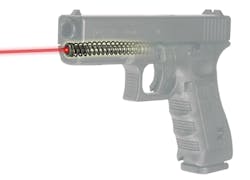Lasers have been around for years, but there are still a host of misconceptions about their use and effectiveness. At the 2012 Shot Show I had the pleasure of discussing lasers with a subject matter expert, Chris Gagliano. Chris works for LaserMax as their Director of Military Products, and is also a retired Marine Sergeant Major. He knows a thing or two about weaponry and tactics.
LaserMax teamed with Advanced Interactive Systems (AIS) at this year’s Shot. By using the AIS PRISim Use-of-force training simulator, Chris was able to demonstrate how lasers can enhance firearm proficiency. Most of the visitors to the shooting booth were able to fire a skill builder course in the simulator, first without using the laser sight and then firing the same course with the laser. The result - even marginal shooters improved their proficiency.
Lest you think lasers are the answer to all your shooting inadequacies, here are a few of interesting facts about lasers:
- They are not cat toys
- Not as effective beyond 20 feet
- Lasers won’t make you react slower
- Point of aim is point of impact
- Aid dry fire training and trigger control
- Help illustrate importance of muzzle discipline during simulator training
Lasers do not take the place of your weapon’s sights, but in certain circumstances they can prove to be invaluable. I’ve been shooting for almost 45 years and swear by iron sights, but in the last three years I’ve shot with laser sights. One thing I’ve noticed is that using a laser sight allows me to acquire a target much faster. Instead of focusing on getting that front sight quickly, I’m able to focus my attention on the threat first and foremost.
As Chris and I discussed this burgeoning industry, it became apparent that more and more LE and military folks are incorporating lasers into their weapon systems. That makes sense, particularly when you consider how important lasers become when one finds himself in a compromising position:
- IED incidents when eyes and/or hands are injured
- Shooting incidents when dominant hand is injured
- When knocked down to the ground
- Shield man
- K-9 officers using one-hand shooting
- Shooting around objects
One of the visitors to the LaserMax/PRIsim booth complained his shots were all low. I watched him shoot and discovered he was looking over his sights trying to see his target, instead of focusing on the laser. Additionally, I noticed he was jerking the trigger. Lasers do not take the place of basic marksmanship. Trigger control, grip, stance… they’re all important in allowing us to deliver an accurate shot. Granted, there will be times when several of the basic tenets of shooting will be compromised, but to the extent that you can employ them all, make sure your shooting technique is as you’ve been taught. Dry firing at home with the laser will dramatically improve your trigger control. I’ve also learned that firing from the prone position is significantly more accurate with a laser when shooters are unable to bring their eyes to their sights.
Using lasers helps minimize collateral damage, reduce tunnel vision and allow for proper use of cover and/or concealment. Red lasers are suitable indoors around the clock, or outside from dusk to dawn. Recently, a green laser was introduced to the laser sight family. Green can be used inside or out, but green is much more visible outside and can be used to engage targets in similar circumstances where red lasers are used.
Studies show that our eyes see green better than any other color in both day and night. But green lasers also have limitations. On a bright, sunny day the green laser would have limited visibility beyond 15 yards. And, since you wouldn’t use your flashlight outdoors on a sunny day, chances are you probably wouldn’t need to engage your laser sight either. Also, green lasers won’t function properly in freezing temperatures. In fact, the temperature range is from 40 – 100 degrees Fahrenheit. That’s something you need to know, particularly if you have a green laser sight on a rifle you store in your trunk and you work in a town that has cold weather.
I wondered why the laser sights were pulsating rather than a steady beam. Chris had the answer. He told me the pulsating light is an attention-getter for both officers and bad guys. Rather than using a static beam like a flashlight, the pulsating laser is highly visible, particularly under stressful conditions. When the eyeballs flatten out due to an adrenaline rush, the pulsating laser is easier to pick up. Just as a strobing light bar attracts attention, so also does the pulsating laser. It’s particularly useful when dealing with subjects high on drugs and alcohol.
For those of you on SWAT teams, IR lasers are now available for use with night vision goggles. Which brings up a point about tactics. Just as the light from your flashlight will telegraph your position to the bad guy, so also will the laser sight if you keep it on during an operation. Laser sights are an invaluable addition to anyone’s tool box, but like any other tool there is a right and wrong way to use it. The bottom line - practice, practice, practice. Know when to deploy flashlights and lasers. Proper use can steal the advantage from someone intent on hurting you.
Stay safe, Brothers and Sisters!
Web Links:
- LivSafe--Stay Aware, Stay Safe!
- Chicago Warriors Midnight Battles in the Windy City by John Wills
- Gripped By Fear by John Wills
About The Author:
John M. Wills spent 33 years in law enforcement as a Chicago Police Officer and FBI Special Agent (Ret). He is a Freelance Writer and Speaker whose third book, TARGETED, is now available online at Amazon and Barnes & Noble. Contact John through his website: www.johnmwills.com.
About the Author
John Wills
John M. Wills is a former Chicago police officer and retired FBI agent. He is a freelance writer and award-winning author in a variety of genres, including novels, short stories and poetry. John also writes book reviews for the New York Journal of Books, and is a member of the National Book Critics Circle. His new book, The Year Without Christmas, is available now. Visit John at: www.johnmwills.com.

